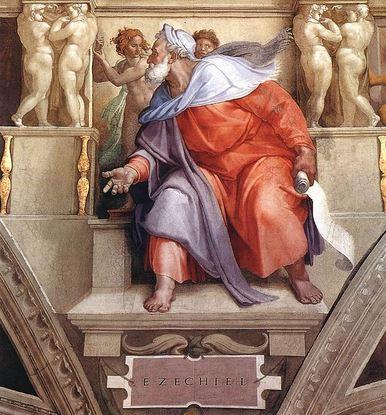Ezekiel

Ezekiel (sometimes spelled Ezechiel) is a significant figure in the Hebrew Bible, particularly in the Book of Ezekiel, which is one of the major prophetic books in the Old Testament. He was a prophet during the time of the Babylonian exile, around the 6th century BCE, and his prophecies are often dramatic, symbolic, and rich in visions. Here's an overview of Ezekiel's life, his prophecies, and his importance:
1. Background and Role as a Prophet:
-
Priest and Prophet: Ezekiel was born into a priestly family and was likely trained as a priest. He was among the exiles taken to Babylon when the Babylonians conquered Jerusalem in 597 BCE. The Book of Ezekiel reflects his dual role as both a priest and a prophet, which is unusual in the Hebrew Bible.
-
Exile: Ezekiel's prophetic ministry occurred during the Babylonian exile, when many Israelites were taken captive after the fall of Jerusalem. This period was marked by a deep sense of loss, despair, and questioning of God's promises. Ezekiel’s role was to provide guidance, warning, and hope to the exiled people.
2. Key Themes and Visions:
-
Visions of God's Glory: One of the most famous aspects of Ezekiel's ministry is his extraordinary visions of God's glory. One of the first visions he describes (in Ezekiel 1) is a highly symbolic and mystifying image of a divine chariot with four living creatures, wheels within wheels, and a radiant cloud. This vision is interpreted as representing the transcendence and holiness of God.
-
The vision is sometimes connected with the idea of the Merkaba, the divine chariot or throne of God, which has similarities to the chariot of fire described in the Book of Ezekiel and the Kabbalistic concept of the Merkaba.
-
-
The Valley of Dry Bones: Another famous vision in Ezekiel (Ezekiel 37) is the vision of the valley of dry bones. In this vision, Ezekiel is shown a valley filled with dry, lifeless bones. God commands him to prophesy to the bones, and they miraculously come to life, symbolizing the restoration of the nation of Israel. This vision is often interpreted as a metaphor for hope, resurrection, and God's promise to restore the exiled Israelites.
-
The Temple Vision: Ezekiel also describes a detailed vision of a future temple in Jerusalem (Ezekiel 40-48). This vision outlines a new, idealized temple that is symbolic of a future restored Israel and God's dwelling place among His people. It is often understood as a vision of spiritual renewal and restoration.
3. Judgment and Hope:
-
Judgment on Israel and the Nations: A significant portion of Ezekiel’s prophecies concerns the judgment of Israel for its idolatry, immorality, and disobedience to God. Ezekiel warns of the destruction of Jerusalem and the eventual fall of the city, which indeed happens during his lifetime with the destruction of the first temple in 586 BCE.
-
Hope for Restoration: Despite his strong messages of judgment, Ezekiel also prophesies hope. He speaks of a time when Israel will be restored, both physically and spiritually. This theme of restoration is found in his vision of the valley of dry bones and the promise of a new covenant with the people of Israel.
4. Symbolic Actions:
-
Ezekiel's Symbolic Acts: Ezekiel was commanded by God to perform various symbolic actions to communicate his prophecies. For example, he lay on his side for 390 days to symbolize the years of Israel's sin, and then on the other side for 40 days to symbolize the years of Judah's sin. He also shaved his head and beard, symbolizing the fate of the people of Jerusalem.
5. Legacy and Influence:
-
Impact on Jewish Thought: Ezekiel's prophecies contributed to the development of Jewish eschatology and the hope for a future messianic era. His vision of the restored temple and the covenant renewal played a key role in shaping later Jewish religious thought, especially in the context of the Second Temple period.
-
Christian Interpretation: Ezekiel’s visions of the resurrection and restoration have also influenced Christian theology, particularly in the context of resurrection and the eventual establishment of God's kingdom.
-
Symbolic and Mystical Influence: Ezekiel's vivid, symbolic imagery—especially the vision of the divine chariot (Merkaba)—has deeply influenced mystical traditions, including Kabbalah and Christian mysticism.
6. The Book of Ezekiel:
The Book of Ezekiel is divided into several sections:
-
Chapters 1–24: Ezekiel’s prophecies of judgment against Israel and Jerusalem.
-
Chapters 25–32: Oracles against foreign nations, including Egypt, Tyre, and others.
-
Chapters 33–39: Messages of hope, restoration, and future blessings for Israel.
-
Chapters 40–48: Ezekiel’s detailed vision of a new temple and the reorganization of Israel.
In Summary:
Ezekiel was a prophet of both judgment and hope, offering divine warnings while also foretelling a time of spiritual and physical restoration for Israel. His visions, including the dramatic chariot vision and the valley of dry bones, are some of the most powerful and enigmatic in the Bible. His influence can be seen not only in Judaism but also in Christianity and mystical traditions.

